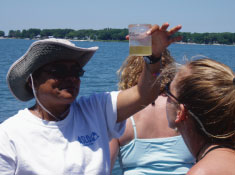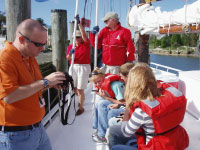COSEE Coastal Trends is a legacy thematic Center that aimed to increase literacy in ocean science with a focus on understanding dynamic coastal trends through partnerships among scientists, educators, students, and the general public. This Center established a number of programs that encouraged collaboration between science and education, and broadly disseminated scientifically accurate information about our coastal oceans. COSEE Coastal Trends was established in 2007.
 | |
The COSEE Coastal Trends Land to Ocean Scientist Educator Partnership team | |
Unique Partnerships,Valuable Lessons: Scientist-Educator Partnerships
The heart of COSEE Coastal Trends was the scientist-educator partnership program, which established teams consisting of a scientist, graduate student, teacher, and Hampton University undergraduate. The teams conducted research over the course of a summer and worked together to create web-based education modules, which included science lesson plans and information on the team’s research topic.
In 2010 COSEE Coastal Trends formed one final scientist-educator team at the University of Maryland’s Horn Point Laboratory in the laboratory of Dr. Tom Fisher. The team’s research focused on the connection between land use and water quality in coastal tributaries. Specifically, they quantified the amount of nitrogen that moves into aquatic systems from watersheds with different types of land uses, from forested to agriculture to urban. To make these estimates, the team combined field sampling of streams and creeks, laboratory analysis of nitrogen concentrations in water samples, and data analysis using GIS to map land uses. The team also developed excellent content and lesson plans highlighting their research. [From left to right in the photo at left: graduate student Lindsay Tempinson, scientist Dr. Tom Fisher, college student Shadaesha Green, teacher Claire Sargo.]
A multitude of valuable lessons have resulted from these scientist-educator partnerships. First, bringing together experts in both the science and education fields resulted in the creation of robust classroom lesson plans that are scientifically rigorous and that utilize proven instructional methods. In addition, evaluations have revealed that each member of the team learned important lessons during the collaborative experience. By participating in an active research project, teachers and undergraduates enhanced their science content knowledge and gained skills that they can apply professionally. In addition, scientists gained a unique perspective on communicating the “big picture” concepts of their research to general audiences through collaboration with educators.
| |  |
| Co-PI Deidre Gibson demonstrates plankton collection to Institute participants |
Getting the Word Out: Coastal Trends Institutes
These institutes address content materials and questions associated with the Coastal Trends education modules. Each institute focuses on the research material presented in the modules, with presentations from the scientists who were involved in the Scientist-Educator Partnership teams. The content material is enhanced by activities and field experiences that support the research. This year’s 4-day workshop focused on expanding ocean science content knowledge and utilizing web-based resources to teach about coastal trends in the classroom. Registered participants represented twelve states from across the nation.
Ocean Science Course Development
COSEE Coastal Trends and Queen Anne’s County Public Schools partnered to develop an Ocean Science course for incoming high school freshmen. The goal of this program was to use the Ocean Literacy: Essential Principles and Fundamental Concepts as the foundation for assembling a semester-long, entry level Ocean Science course entitled "An Introduction to Our Dynamic Ocean". The course curriculum draws from existing lessons designed to utilize real-time and near real-time data and scientific discoveries. This course uses inquiry-based, hands-on activities to stimulate interest in ocean science, develop critical thinking skills, and increase science literacy.
 | |
STEM students learn about ocean movement aboard the skipjack
Nathan of Dorchester | |
The course was assembled during the summer of 2008 and pilot-tested by teachers in Queen Anne’s County, Maryland during the 2008-2009 school year. During the summers of 2009 and 2010, we offered implementation institutes for teachers who plan to teach ocean sciences, either as a full course or as modules in other courses.
Horn Point STEM Center
The Horn Point Science, Technology, Engineering and Mathematics (STEM) Center seeks to increase student interest and knowledge in the STEM disciplines and experience in “real world” scientific research. COSEE Coastal Trends partnered with the Horn Point STEM Center and regional public school districts in their initiatives to integrate science research into each school system’s curricula. The program activities are based on the Coastal Trends scientist-educator partnership program education modules and are designed to increase student’s ability to comprehend scientific processes, including hypothesis formulation, conducting research, data analysis, interpretation of results and communication of conclusions. Over 18,000 students have been introduced to these ocean science topics.

